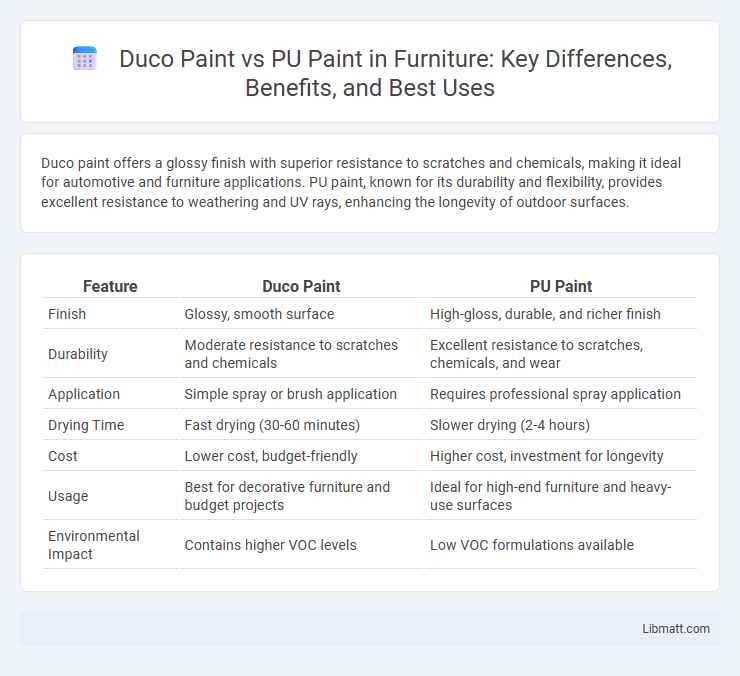Duco paint offers a glossy finish with superior resistance to scratches and chemicals, making it ideal for automotive and furniture applications. PU paint, known for its durability and flexibility, provides excellent resistance to weathering and UV rays, enhancing the longevity of outdoor surfaces.
Table of Comparison
| Feature | Duco Paint | PU Paint |
|---|---|---|
| Finish | Glossy, smooth surface | High-gloss, durable, and richer finish |
| Durability | Moderate resistance to scratches and chemicals | Excellent resistance to scratches, chemicals, and wear |
| Application | Simple spray or brush application | Requires professional spray application |
| Drying Time | Fast drying (30-60 minutes) | Slower drying (2-4 hours) |
| Cost | Lower cost, budget-friendly | Higher cost, investment for longevity |
| Usage | Best for decorative furniture and budget projects | Ideal for high-end furniture and heavy-use surfaces |
| Environmental Impact | Contains higher VOC levels | Low VOC formulations available |
Introduction to Duco Paint and PU Paint
Duco paint is a nitrocellulose-based coating known for its high gloss and fast-drying properties, commonly used in automotive refinishing and wooden furniture. PU paint, or polyurethane paint, offers superior durability, chemical resistance, and flexibility, making it ideal for heavy-duty applications and surfaces exposed to harsh environmental conditions. You can choose Duco paint for vibrant, quick finishes, while PU paint suits long-lasting protection with excellent adhesion.
Key Differences Between Duco and PU Paint
Duco paint offers a glossy, vibrant finish commonly used in automotive and furniture applications, while PU (Polyurethane) paint provides superior durability, chemical resistance, and flexibility suited for industrial and high-performance surfaces. You'll notice Duco paint dries faster but is less resistant to scratches and environmental factors compared to PU paint, which typically requires longer curing time but ensures a more resilient coating. Choosing between Duco and PU paint depends on your priorities for finish quality and long-term protection.
Composition and Chemical Properties
Duco paint primarily consists of nitrocellulose lacquer combined with solvents and pigments, resulting in fast drying times and a glossy finish that is prone to cracking and fading under UV exposure. PU (polyurethane) paint contains polyurethane resins that form a durable, flexible film chemically resistant to abrasion, chemicals, and weathering, making it ideal for high-performance applications. The chemical structure of PU paint provides superior adhesion and elasticity compared to the brittle nature of Duco paint's nitrocellulose base.
Application Processes for Duco and PU Paint
Duco paint application involves multiple thin layers applied with a spray gun, followed by drying and sanding to achieve a smooth finish often used in automotive and furniture industries. PU paint application requires surface cleaning, primer application, and spraying multiple coats of polyurethane paint, which chemically cures for enhanced durability and resistance. Both processes demand precise environmental controls to ensure adhesion and optimal curing conditions.
Durability and Longevity Comparison
Duco paint offers moderate durability with good resistance to fading and chipping but typically requires more frequent maintenance compared to PU paint. PU (Polyurethane) paint provides superior longevity due to its excellent chemical resistance, hardness, and ability to withstand harsh weather conditions, making it ideal for surfaces exposed to heavy wear. Selecting PU paint ensures your surfaces maintain a vibrant and durable finish over time, reducing the need for frequent repainting.
Surface Finish and Aesthetic Appeal
Duco paint delivers a smooth, glossy surface finish with vibrant color retention, making it ideal for automotive and furniture applications where high aesthetic appeal is crucial. PU paint provides a durable, chemical-resistant coating with excellent UV stability, ensuring a long-lasting, sleek appearance even under harsh environmental conditions. Both types offer superior finish quality, but Duco paint excels in color richness, while PU paint is favored for its robustness and longevity.
Maintenance and Cleaning Requirements
Duco paint requires regular maintenance with mild detergents to prevent surface dullness and peeling over time, ensuring vibrant color retention. PU (Polyurethane) paint offers superior resistance to chemicals and abrasions, making it easier to clean with minimal effort while maintaining a glossy finish. Both paints benefit from prompt removal of contaminants, but PU paint's durable topcoat reduces the frequency of deep cleaning and refinishing.
Cost Analysis: Duco vs PU Paint
Duco paint generally incurs higher initial costs compared to PU paint due to its premium quality and complex application process. PU paint offers a cost-effective solution with lower material and labor expenses while still providing durable and glossy finishes. Evaluating long-term maintenance reveals that PU paint may reduce overall expenses, making it a budget-friendly choice for projects requiring both aesthetics and durability.
Environmental Impact and Safety Considerations
Duco paint typically contains higher levels of volatile organic compounds (VOCs), which contribute to air pollution and pose health risks during application. PU (polyurethane) paint often offers improved durability with lower VOC emissions, making it a safer choice for both your health and the environment. Choosing PU paint can reduce exposure to toxic fumes and minimize ecological impact, promoting a safer workspace and greener finishing solution.
Choosing the Right Paint for Your Project
Duco paint offers a smooth, glossy finish ideal for automotive and metal surfaces due to its high durability and ease of application. PU paint, or polyurethane paint, provides superior chemical and scratch resistance, making it suitable for industrial projects requiring long-lasting protection. Selecting the right paint depends on surface type, exposure conditions, and desired finish quality, with Duco favored for aesthetics and PU preferred for robustness.
Duco paint vs PU paint Infographic

 libmatt.com
libmatt.com